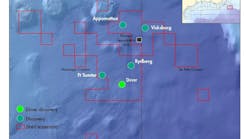Editor's note: This Subsea Systems section first appeared in the September-October 2022 issue of Offshore magazine. Click here to view the full issue. Subsea Systems covers the latest subsea systems technology developments, projects and advances being utilized in the offshore energy industry.
Ariana Hurtado, Houston
Plenty of subsea tree awards up for grabs in coming years
The subsea production sector is forecast to dominate the offshore industry due to increased offshore activity and declining offshore production costs, according to various news reports.
Abhinav Parashar, an analyst with Rystad Energy, told Offshore, "We expect to see substantial growth in the subsea market in the long term, with a forecast compound annual growth rate of 10% from 2021, reaching a little over $31 billion in 2025. Deepwater developments—meaning those in between 125 and 1,500 meters of water—are expected to account for the largest share of subsea purchases in 2022 at close to $12 billion, representing almost half of total subsea market purchases."
Rystad predicts that Europe and South America will continue to be the two main subsea hubs, and the two regions are expected to see an increase from 2022 of almost 21% and 24%, respectively, in terms of subsea purchases next year. Together, they will account for half of all global subsea purchases in 2023.
"The increased spending in Europe will primarily be driven by an uptick in activity off Norway, particularly for smaller projects and subsea tiebacks, with Norwegian state-controlled energy giant Equinor and Aker BP in the driving seat, whereas Petrobras and Exxon Mobil will be the top clients in South America," Parashar said.
In July TechnipFMC signed a letter of intent with Equinor for an integrated FEED study on its BM-C-33 project offshore Brazil. The study includes an option to proceed with a direct award to TechnipFMC for the integrated engineering, procurement, construction and installation (iEPCI) phase of the project. The iEPCI contract, which TechnipFMC defined as more than $1 billion, would cover the entire subsea system, including Subsea 2.0 tree systems, manifolds, jumpers, rigid risers and flowlines, umbilicals, pipeline end terminations, and subsea distribution and topside control equipment.
"The South American market is seeing rising numbers of subsea tree contracts awarded, a trend expected to continue over the medium term. While the region saw an average of only 54 subsea trees awarded per year between 2018 and 2021, numbers are expected to jump to an average of 74 subsea trees per year between 2022 and 2025."
In August TechnipFMC was awarded a contract by ExxonMobil affiliate, Esso Exploration and Production Guyana Ltd., for the Gas to Energy Project in Guyana. The contract is worth between $75 million and $250 million, and TechnipFMC will provide EPCI of subsea risers and pipelines.
"Guyana emerged as a burgeoning market for subsea players in 2017 when Exxon Mobil ordered 17 subsea trees for its Liza Phase 1 development, the nation’s first offshore project," Parashar said. "Since then, exploration success at the prolific Stabroek Block led operator Exxon Mobil to commission 131 subsea trees for its Liza Phase 1, Liza Phase 2, Payara and Yellowtail projects—all of them were won by TechnipFMC in 2017, 2018, 2020 and 2022, respectively. The US major has several significant discoveries lined up to be developed that will require a total of 210 subsea trees to be awarded through to 2030—a number that could increase if the operator hits further success in exploration."
In the Norwegian North Sea area, Aker BP awarded subsea contracts to Aker Solutions and Subsea 7 in August for its Trell and Trine development.
"Norway and the UK will also see bustling subsea activity in the coming years, driven by upcoming tieback projects in the region," Parashar continued.
Rystad predicts about 200 subsea tree awards for such projects in Norway are expected between 2022 and 2025, accounting for 75% of total subsea tree awards in the country. Equinor’s Wisting project and Aker BP’s NOAKA development are a few of the major projects in the pipeline in that region.
"Between 2022 and 2025, close to 1,100 subsea trees are likely to be awarded globally," Parashar concluded. "Although numerous frame agreements and alliances between a number of operators and suppliers are already in place, there remain plenty of subsea tree awards up for grabs in the coming years if projects move ahead as planned."
Subsea cost reductions could help drive more deepwater projects forward
Rising oil and gas demand and supply disruption caused by the war in Ukraine could spur increased relatively high-capex deepwater and ultradeepwater projects reliant on subsea systems, according to a GlobalData report released in July.
Oil and gas analyst Ravindra Puranik said, “With numerous countries shunning Russian oil and gas, there is an increasing need to ramp up production from other regions.”
Producers in the subsea hotspots offshore the UK and Norway continental shelves are taking steps to ramp up their E&P activities to support the pivot away from Russian imports. The UK government is playing its part by staging a new licensing round for North Sea blocks this fall.
Norway has recently permitted its offshore operators to raise output from several oil and gas fields.
"Subsea technology has proven to be reliable in waters at a variety of depths," Puranik said. “Since most of the production, processing, storage and power distribution equipment is moved on to the seabed, it minimizes the capex and opex in offshore environments. This is encouraging companies to make significant investments in subsea projects.
“High capital costs are a major deterrent for deepwater oil and gas projects. However, several efforts being directed toward reducing costs, including streamlining material procurement, optimizing subsea architecture and simplifying equipment installation, are helping in reducing the overall costs. Furthermore, subsea contractors are achieving significant cost reductions by lowering the project execution cycle time.”
Aker Solutions issues subsea updates
Aker Solutions is progressing construction for various major offshore projects in Norway and Australia, according to the company’s latest results statement.
Activity is increasing on the Johan Castberg project in the Barents Sea, after the hull of the FPSO arrived at Stord in April. Several prefabricated modules have since been installed, including the lower part of the turret.
The second batch of five standardized subsea trees for the development were dispatched from Brazil and have arrived in Norway.
All subsea templates have been installed for Equinor’s Breidablikk project (a tieback to the Grane platform), and fabrication has started in Egersund for Chevron’s Jansz subsea gas compression project off Western Australia.
Delivery continues of further subsea structures for projects for ConocoPhillips and Equinor, and the decommissioned Gyda platform and two others from the Valhall Field are in Stord for dismantling.
As for the Northern Lights carbon storage project in the North Sea, assembly has started in Brazil of the first subsea tree for CO2 injection, with construction also progressing on the subsea template at the Egersund yard.




